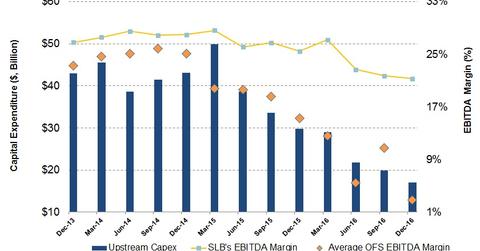Will Upstream Operators’ Capexes Affect SLB’s 1Q17 Margin?
In the past couple of years, some major US upstream and integrated companies have reduced their capital expenditures (capex) following crude oil’s sharp fall.
Feb. 23 2017, Updated 9:35 a.m. ET

Upstream operators’ capex cut
In the past couple of years, some major US upstream and integrated companies have reduced their capital expenditures (capex) following crude oil’s sharp fall. From 4Q15 to 4Q16, 18 of the most prominent names in this space slashed their total capex by 43%.
Lower upstream capexes resulted in lower prices for oilfield equipment and services (or OFS) companies’ services and products, which reduced their operating revenues and margins.
From 3Q16 to 4Q16, these companies’ capexes fell only 14%, as crude oil prices started to recover in 2016. Many of these companies have started to increase their 2017 capex budgets. Read Why Cabot Awaits the Atlantic and Constitution Pipeline Projects to know more.
Higher capex on energy drilling and production could lead to improved margins for OFS companies going forward.
Schlumberger’s EBITDA margin versus industry
As shown in the graph above, Schlumberger’s (SLB) EBITDA (earnings before interest, tax, depreciation, and amortization) margin was negatively affected as upstream companies slashed their budgets.
From 4Q15 to 4Q16, SLB’s EBITDA margin, or its EBITDA as a percentage of its revenue, contracted to 21% from 25.5%. Eight of the most prominent OFS companies’ average EBITDA margins contracted to an average of 2.6% in 4Q16 from 10.8% in 3Q16. An EBITDA margin is a measure of a company’s operating earnings. SLB makes up 6.4% of the iShares North American Natural Resources ETF (IGE).
